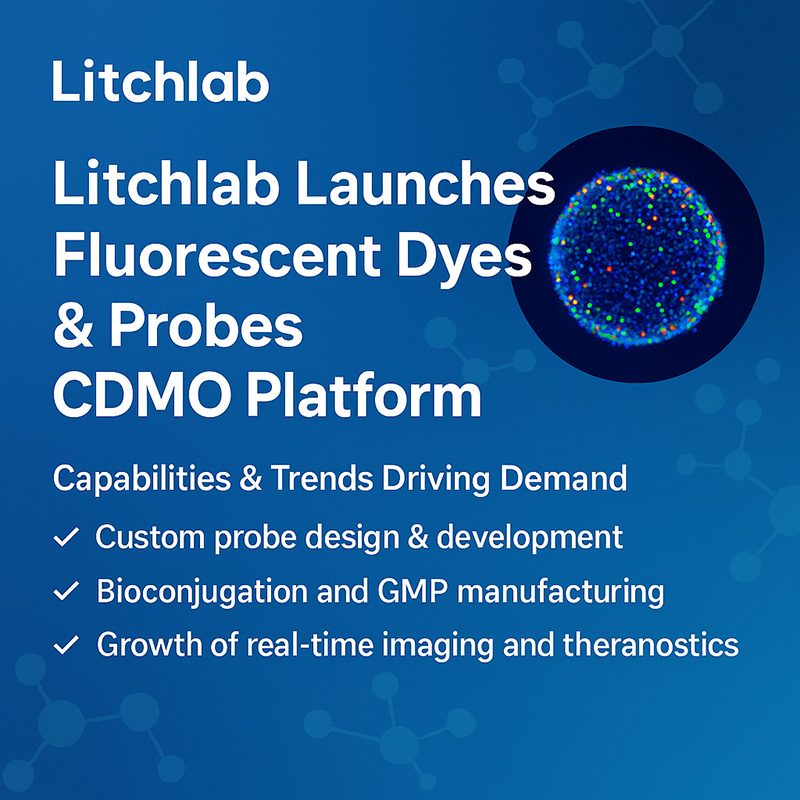
Litchlab, a Contract Development and Manufacturing Organization (CDMO) specialized in next-generation drug delivery and diagnostic platforms, has announced the official launch of its Fluorescent Dyes & Molecular Probes CDMO Service Line, providing end-to-end solutions spanning custom synthesis, scalable manufacturing, conjugation, and regulatory support.
As the life sciences industry shifts toward real-time visualization, molecular precision, and non-invasive monitoring, the global demand for robust, tunable, and biocompatible fluorescent systems continues to surge. From tumor-targeting NIR-II dyes to enzyme-activatable probes for inflammation, the applications of molecular probes are moving from bench to bedside.

Organic small-molecule dyes: FITC, Cy3/Cy5, Alexa Fluor™, Rhodamine, BODIPY, NIR-I/NIR-II fluorophores
Fluorescent nanoparticles: Quantum dots (CdSe/ZnS, InP), polymer dots, gold nanoclusters
Smart activatable probes: ROS-sensitive, pH-triggered, MMP-cleavable, glutathione-responsive
Multimodal probes: Fluorescence–MRI, Fluorescence–PET, Fluorescence–Photoacoustic (PAI)
High-efficiency coupling with:
Monoclonal antibodies, peptides, aptamers, nucleic acids
Liposomes, micelles, polymer nanoparticles, EVs
Site-specific labeling, controlled stoichiometry, linker optimization
Stability optimization in biological matrices (serum, plasma, interstitial fluid)
Custom process chemistry optimization for dye synthesis and purification
GMP fill-finish for injectable, topical, or lyophilized probe formats
Sterile filtration, endotoxin control, moisture and light protection packaging
DLS, UV-Vis, fluorescence spectra, quantum yield, hydrodynamic diameter, and zeta potential profiling
Long-term and accelerated stability studies (ICH Q1A) under various storage conditions
Full CMC documentation and probe-specific safety dossiers
ICH-compliant impurity profiling and photostability analysis
Regulatory strategy support for:
Imaging agents (IND type V)
Optical diagnostics (510(k), IVDR)
Theranostic bioconjugates (IND type II or combination products)
The global fluorescent probe market is expected to exceed USD 7 billion by 2030, fueled by:
✅ Rise of real-time intraoperative imaging systems (e.g., fluorescence-guided surgery)
✅ Increasing use of targeted fluorescent tracers in clinical trials (oncology, neurology)
✅ Growth of high-throughput cell imaging and multi-color pathology analysis in research
✅ Push for activatable and environment-responsive probes in inflammatory disease detection
✅ Regulatory acceleration for diagnostic–therapeutic conjugates (Dx/Rx hybrids)
| Field | Examples |
|---|---|
| Oncology | Tumor-targeted NIR-II dyes for surgical navigation, tumor–stroma probes |
| Neuroscience | BBB-penetrating probes for brain imaging, neuroinflammation sensors |
| Pathology & IVD | Multiplex immunostaining reagents, chromogenic + fluorescent dual-use kits |
| Theranostics | Fluorescent–drug conjugates for real-time therapeutic tracking |
| Screening Platforms | High-content screening dyes for phenotypic analysis, apoptosis/mitochondrial sensors |